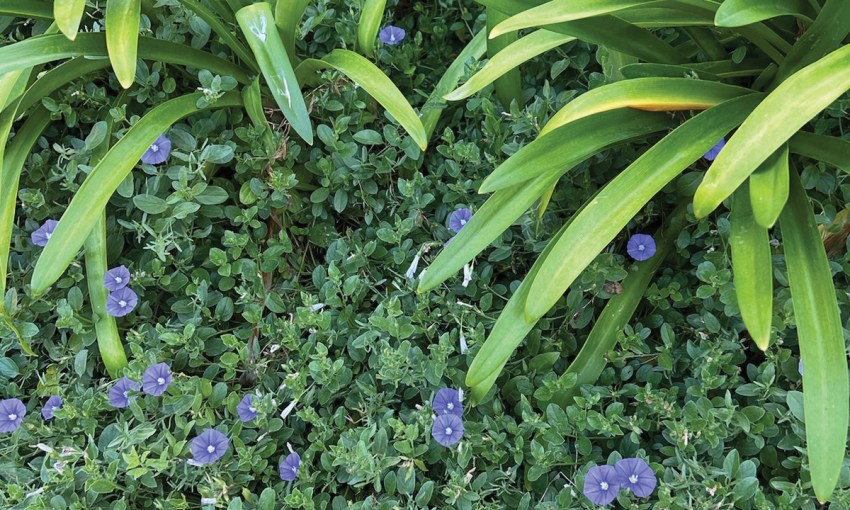Tired of constantly replenishing your garden mulch? Looking for an alternative that is not only cost effective, low maintenance and eco-friendly, but adds a touch of luxury and beauty to your landscape? Then check out the eco-friendly solution that is taking the horticultural world by storm … using groundcover plants.
How to use groundcover plants
Mulch has always been a necessity to the home gardener, helping to protect your garden from the harsh elements and deterring those pesky weeds. But replenishing mulch regularly becomes a time-consuming and costly expense that not all are capable or willing to do.
Enter nature’s alternative.
Imagine having all the same benefits that accompany using garden mulch but in the form of a beautiful and lush carpet of colour that adds a touch of elegance and sustainability to your garden. Not only are groundcover plants visually appealing but also offer a multitude of benefits that go beyond what traditional mulch can provide.
Weed suppression and erosion control
Groundcover plants establish a lush carpet of foliage and intricate root networks, effectively crowding out weed growth. This ability to suppress weeds not only creates a more nourishing atmosphere for surrounding plants but also minimises nutrient competition.
Additionally, groundcovers excel at preventing soil erosion, particularly on slopes, as their shallow, yet intricate, root systems interlock, fortifying the soil against erosion caused by intense rainfall.
Temperature regulation and fire resistance
While mulch is known for its insulating properties, groundcover plants take temperature regulation to the next level. The thick, low-growing foliage acts as a natural insulator, moderating soil temperatures by providing both shade and insulation. This can be especially beneficial in extreme weather conditions, helping plants withstand the scorching heat of summer or the coolness of winter.
This also makes a significant difference in the event of a fire. Mulch itself can become quite combustible because it is naturally dry, but certain groundcover plants can lock moisture into their foliage and the soil for extended periods of time, and even resist or recover from fire quickly.

Biodiversity boost
The environmental benefits of using groundcover plants allows you to both nurture the beauty of your garden and host a thriving ecosystem, by attracting beneficial insects, such as pollinators and predatory insects that keep harmful pests at bay. The increased biodiversity contributes to a healthier and more resilient garden.
Low maintenance
If you prefer to keep a low maintenance garden then groundcover plants are ideal for you. Once established, many are drought tolerant, hardy, and easy to care for with minimal maintenance, resulting in a stunning landscape without the need for constant attention or the need to replenish every few months.
Groundcovers to try in your garden:
Convolvulus sabatius, is a perennial trailing plant with delicate blue funnel-shaped flowers, making it an excellent groundcover to add beauty to your garden.
Grevillea Gin Gin Gem is a compact and vibrant Australian native shrub, adorned with striking red flowers that add a touch of elegance to gardens, all while attracting native birds.
Myoporum parvifolium, is the perfect drought-tolerant groundcover plant. Its prostrate growth habit makes it the ideal choice for soil erosion control and weed suppression.

Stachys byzantina, commonly referred to as Lamb’s-ear, is renowned for its soft, velvety silver-grey leaves, resembling its namesake.
Thymus serpyllum, or creeping thyme, is a low-growing aromatic herb with small, fragrant leaves. Ideal as a groundcover, because it forms a dense carpet and produces tiny pink or purple flowers making an ideal verge lawn. Makes a statement without needing to be regularly mown.
Trachelospermum Flat Mat, is a variety of star jasmine, with glossy green foliage and fragrant white flowers. This cultivar makes a spectacular addition to your garden, providing both beauty and a sweet fragrance.
Eremophila Kalbarri Carpet is a low-spreading Australian native shrub, featuring attractive silver-green foliage and vibrant flowers. With its drought tolerance and ground-hugging growth, it proves to be an excellent groundcover option.
Soleirolia, commonly known as Baby’s Tears, is a delightful groundcover plant with tiny, round leaves that create a lush carpet effect. Its delicate appearance and vigorous spreading make it a popular choice for shady areas in your garden.
Viola hederacea, or Australian violet, is a low-growing perennial with heart-shaped leaves and delicate purple flowers. This native groundcover plant thrives in shaded areas, providing a graceful carpet of green.
Chlorophytum comosum, also known as the spider plant, is a popular indoor and outdoor plant choice with arching leaves and its ability for vigorous growth through replication, in the form of baby versions of itself. Its adaptability and air-purifying qualities make it an excellent addition to your home garden.
Hedera, commonly known as ivy, is a classic and evergreen groundcover plant known for its vigorous climbing or spreading habit. It adds a timeless touch to gardens, walls, and landscapes alike.
So, next time you contemplate dressing up your garden beds, consider the enchanting allure of groundcover plants – the living, breathing alternative to mulch that transforms your landscape into a work of art.
This article first appeared in the Autumn 2024 issue of SALIFE Gardens & Outdoor Living magazine.



